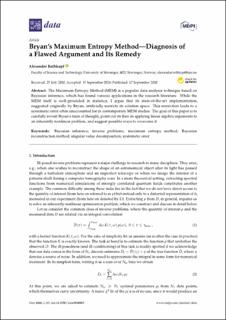| dc.contributor.author | Rothkopf, Alexander Karl | |
| dc.date.accessioned | 2021-01-20T12:54:36Z | |
| dc.date.available | 2021-01-20T12:54:36Z | |
| dc.date.created | 2020-10-03T09:00:17Z | |
| dc.date.issued | 2020-09 | |
| dc.identifier.citation | Rothkopf, A.K. (2020) Bryan’s Maximum Entropy Method—Diagnosis of a Flawed Argument and Its Remedy. Data, 5(3) | en_US |
| dc.identifier.issn | 2306-5729 | |
| dc.identifier.uri | https://hdl.handle.net/11250/2723934 | |
| dc.description.abstract | The Maximum Entropy Method (MEM) is a popular data analysis technique based on Bayesian inference, which has found various applications in the research literature. While the MEM itself is well-grounded in statistics, I argue that its state-of-the-art implementation, suggested originally by Bryan, artificially restricts its solution space. This restriction leads to a systematic error often unaccounted for in contemporary MEM studies. The goal of this paper is to carefully revisit Bryan’s train of thought, point out its flaw in applying linear algebra arguments to an inherently nonlinear problem, and suggest possible ways to overcome it. | en_US |
| dc.language.iso | eng | en_US |
| dc.publisher | MDPI | en_US |
| dc.relation.uri | https://www.mdpi.com/2306-5729/5/3/85 | |
| dc.rights | Navngivelse 4.0 Internasjonal | * |
| dc.rights.uri | http://creativecommons.org/licenses/by/4.0/deed.no | * |
| dc.subject | Bayesian inference | en_US |
| dc.subject | inverse problems | en_US |
| dc.subject | maximum entropy method | en_US |
| dc.title | Bryan’s Maximum Entropy Method—Diagnosis of a Flawed Argument and Its Remedy | en_US |
| dc.type | Peer reviewed | en_US |
| dc.type | Journal article | en_US |
| dc.description.version | publishedVersion | en_US |
| dc.rights.holder | (c) 2020 by the author | en_US |
| dc.subject.nsi | VDP::Matematikk og naturvitenskap: 400 | en_US |
| dc.subject.nsi | VDP::Mathematics and natural scienses: 400 | en_US |
| dc.source.volume | 5 | en_US |
| dc.source.journal | Data | en_US |
| dc.source.issue | 3 | en_US |
| dc.identifier.doi | 10.3390/data5030085 | |
| dc.identifier.cristin | 1836721 | |
| dc.relation.project | Norges forskningsråd: 286883 | en_US |
| cristin.ispublished | true | |
| cristin.fulltext | original | |
| cristin.qualitycode | 1 | |

